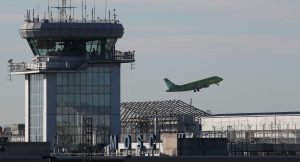
Airplane Accidents photo “Quartz”
Airplane Accidents-Crash of Saratov Airlines Flight 703. The afternoon of February 11th, 2018 saw, not far from Moscow’s Domodedovo Airport, the crash of an AN-148-100B aircraft enroute from Moscow to Orsk, Russia near the Kazakhstan border.
The aircraft carried 65 passengers and six crewmembers. There were no survivors. While the investigation is ongoing some facts have been ascertained.
The aircraft was first flown in May of 2010and registered to Rossiya Airlines in late June of the same year. While in that service the aircraft had experienced two mechanical failures. The first was an engine shutdown after it surged in flight. The second was a nose wheel failure on takeoff in August of 2013.
The aircraft was leased to Sarattov Airlines in February of 2017, a year prior to the crash. The flight was a regularly scheduled domestic medium haul flight. Scheduled departure time was 1400 hours, (2:00 PM), local. Actual departure was 21 minutes later. Six minutes into the flight the aircraft had reached an altitude of 5,900 feet and an airspeed of 320 knots. At that point the aircraft began a steep, 30 degree, descent. It fell below radar coverage at 3,000 feet.
Seven minutes into the flight the aircraft struck the ground and burst into flames. The wreckage was scattered across a kilometer of ground. Delays due to snow accumulation caused rescue workers to take 2.5 hours to reach the scene.
The flight data and cockpit voice recorders were recovered the day after the crash. Eyewitnesses reported the aircraft on fire as it came down but surveillance video shows flames after the crash occurred.
The Russian Interstate Aviation Committee, similar to the NTSB in the U.S., immediately opened as investigation. Examination of the flight data recorder showed that the pitot heating system had not been turned on. The pitot system is used to give airspeed information. The Air France Flight 447 crash of 2009 in the South Atlantic was, was initially “suggested” the main cause of the crash. However the final report list “a series of pilot errors and failure to react effectively” was the main cause. We provided key forensic meteorological analysis on this case.
Weather
The weather at or near takeoff time was light snow to snow showers. The temperature was -5 C or approximately 24 degrees F. Records obtained by investigators noted than the pilot had declined de-icing prior to takeoff. West Coast Weather has been involved with other de-icing issues and one needs to review upper air charts and many weather charts to come to a concluson.
Data analysis also shows, due to the lack of heat in the pitot system, that three different airspeed indicators all gave incorrect information. One at a higher speed than indicated by radar, the second at a lower speed and the third at zero indicated airspeed.
The aircraft was under manual control and while the copilot attempted to slow the rate of descent the captain either did not hear his attempt or ignored the verbal warning about the loss of control.
The pilot was 51 years old with 5,000 hours of flight experience, 2800 of which were in the AN-148 aircraft. He had, however, only 58 hours as pilot in command. The copilot was 35 with far fewer hours in the air. As an aside, but possibly relevant, the pilot’s health certificate had expired two days prior to this flight.
The Russian prosecutor’s office also opened a criminal investigation into the matter. It found reports that the airline had been banned from international travel in 2015 due to unspecified safety violations but which included violating the procedures for changing the oil in the gearboxes and washing the air starter filters. The international flight restriction was lifted in 2016 after policy and procedure changes were instituted.
At present both civil and criminal investigations continue. Definitive results should be available in a few months.
Article written by Robert Morthorst